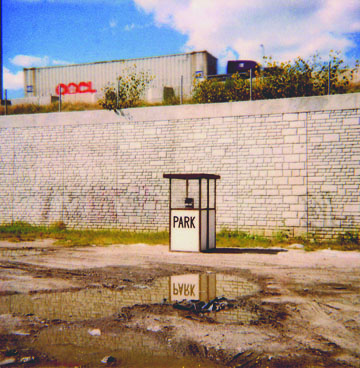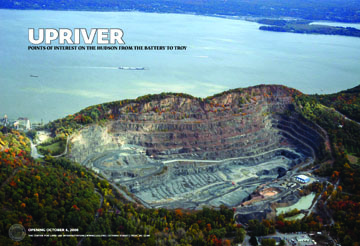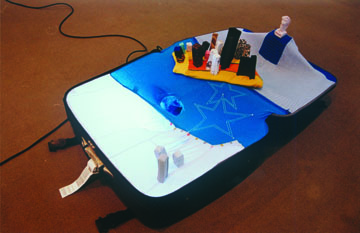* Revised February 4, 2009.
Lize Mogel, Mappa Mundi, digital print, 2008. Courtesy Melville House and iCI.
Melville House and iCI recently co-published the exhibition catalogue for Experimental Geography, an exhibition of contemporary art that engages geography organized curated by New York-based Nato Thompson and organized by iCI. It will be on view at the Rochester Art Center in Minnesota from February 7 to April 18 and then travel to other institutions. The following interview about the project was conducted with Thompson over email.
Daniel Quiles: How did the idea for the Experimental Geography exhibition come about?
Nato Thompson: I have long been a friend and colleague of the artist Trevor Paglen, who has been quite influential in the development of this practice. As an artist and geographer, he is often borrowing from these fields in order to produce methods for interpreting space. As much as the world at large still believes firmly in the categories of the Enlightenment, such severe distinctions between fields of study can be unhelpful if not absolutely misleading.
Looking around the contemporary art world today, we find numerous practices interested in experimental methods for understanding space itself—from the important work of the Center for Land Use Interpretation in Culver City, California, to the experimental walking tours of Francis Alÿs in Mexico City, to poetic interpretations confounding body and place such as with artist Ilana Halperin. The practices are out there and it felt as though the often used lens of art history was simply clunky in interpreting this work. So the exhibition is an opportunity to construct a new lens from an emerging form.
Trevor Paglen, The Salt Pit (Shomali Plains northeast of Kabul, Afganistan), Chromogenic print, 2006.
DQ: A number of the artists and collectives involved in the show trace their roots back to Chicago, in particular the School of the Art Institute of Chicago,and some of whom were featured in the recent group exhibition you curated at the Armory, Democracy in America. How would you say the Chicago milieu conditioned the formation of some of the practices outlined in Experimental Geography?
NT: Well I will admit I went to graduate school at SAIC and also remain an avid admirer of the non-object-based collectivist practices that have been maturing in Chicago for over a decade. Artist and activist Daniel Tucker started a phenomenal journal titled AREA, which looks at urban space in Chicago from a variety of lenses including art but also those of race, gender, policy, minority histories, and on and on. This magazine has allowed numerous communities to come together under the specific frame of the city they live in. It’s a compelling umbrella that has many associations with Henri Lefebvre’s approach to geography in the 1950s.
But I should also say that the Center for Urban Pedagogy based in Brooklyn is doing important work as well. In their case, they are focusing on pedagogy and urbanism. And then we would also have to look at the incredible work of the Italian collective Multiplicity, who utilize aesthetic considerations of contemporary art to interrogate specific spaces from the Mediterranean Sea to Israel and Palestine.
The Center for Land Use Interpretation, Project Poster, inkjet print, 2007. Courtesy Melville House and iCI.
DQ: What is the place of form in contemporary art that is so closely wedded to other fields, such as journalism or activism? Do you feel that the traditional opposition between “form” and “content” still holds, or that contemporary artists have found new ways to integrate them?
NT: As much as the onslaught of cultural production over the last fifty years has radically altered capital’s relationship to aesthetics, it has also made us much more aware that knowledge has a form, and that there are a myriad of forms for the delivery of information and the production of knowledge. Basically, knowledge is a performance, whether it is the stage of the classroom, or the aesthetics of a typeface in a book, to the performance in a street, to a multi-channel video projection. Now that many forms of anthropology and geography tend to be more reflexive, we find more room for ambiguity, which typically is the purview of artistic practice.
There are many types of work in the exhibition, ranging from some that are deeply poetic while others are slightly more didactic. These approaches can still remain under one umbrella but their sense of urgency and their techniques of information delivery vary.
DQ: In your introductory text for the catalogue, you write, “The field of experimental geography (and many other interdisciplinary practices) derives from…moments of theoretic rupture. They are born when the extant frame is not wide enough and we must begin to understand the mechanisms of power, finance, and geopolitical structures that produce the culture around us” (p. 16). Your argument here seems to be about the field of art itself—that the exigencies of the larger economic or political sphere force art to expand into other disciplines. Would you argue that many artists today actively search for such areas through which art’s scope might be widened?
NT: It is in the modernist tradition of the arts to forever try to explode the scope of art. It has an historic negative logic that has been both constructive and obviously destructive. I think this tendency certainly drives much work by artists, but I don’t want to completely hand it over to this impulse. Equally, I think there is a skepticism of the traditionally conservative foundations of art (the fact that the economy of art is ultimately home decoration) and to what degree it is productive to be connected to this discourse.
We live in contingent and flexible times. This is the nature of what is referred to as the neoliberal economy. Cultural producers today are always hedging their bets and playing numerous games at once. That is to say, the growth of experimental geography could have as much to do with expanding art as it does with artists wanting to have two potential jobs at the same time.
And finally, smart people out there know right now that many of the supposedly distinctive fields, such as art and geography, are outmoded ways of thinking. They operate more in a world that has jobs and institutions but may not ultimately allow for better thinking. Many artists, thinkers, creators, and cultural producers are simply looking for the most evocative way to consider the world we live in. These are the forms that this line of inquiry has produced and they hope that the institutions and world will catch up at some point.
Yin Xiuzhen, Portable Cities: Singapore, mixed media, 2003. Courtesy Melville House and iCI.
DQ: I am interested in how a more traditional art object is retained in much neoconceptualist practice. That is, the artist undertakes a project that perhaps encompasses activities outside of the sphere of art—elements of service, research, journalism, or activism—but finds a way to produce marketable objects such as works on paper, photographs, sculpture, and the like. In this way the art object is not necessarily the result of the project, nor a stand-in for its totality; it is merely a partial offshoot. Can we conceive of the map in a similar way for some of the artists in Experimental Geography?
NT: Well, there are a few things to untangle here. First of all, objects are not uninteresting nor without pedagogic capacity. Think of the wunderkammen with its unicorn horns, mollusks, and paintings on the head of a pin. The original museums were set in motion by a profound curiosity (mixed with deep-seeded colonialism). Curiosity is a productive force in the development of thinking/being/becoming. So, we need not write off objects altogether. Maps have materiality and well, they are a useful form in experimental geography. Yin Xiuxen, a Chinese artist in the exhibition whom I am convinced would not consider herself an experimental geographer, nonetheless sews suitcases together from fabrics in order to discuss manufacturing, materiality, and globalism. It is a poetic object.
But the next part of your question pertains to economies where we often find artists need to produce something that sells in order to subsidize their life. Somehow they need to dovetail their desire to communicate with their desire to pay rent. Sounds like the information economy to me. I don’t have a problem with such things as long as folks are more transparent about it. The best types of work use the form directly for the purposes of making their effect as interesting as possible. This sometimes isn’t as possible when you put that ol’ “I have to sell this as well” into the mix. What I don’t like is when artists pretend that these dual desires are never in conflict in their work, that they don’t have to wrestle with these competing needs. Such blatant myopia is rampant in contemporary art. Of course, contemporary critics are so complicit in it you would think they have never heard of the idea of political economy. Oh well.

Deborah Stratman, image from Park, Polaroid print, 2000. Courtesy Melville House and iCI.
DQ: Many of the practices featured in Experimental Geography owe a clear debt to the Situationists, the radical pan-European group that explored artistic and political interventions in the city throughout the late 1950s and 1960s. In what ways would you say that they break with the Situationists? One convention that strikes me as somewhat un-Situationist is the guided tour that is utilized by groups such as the Center for Land Use Interpretation and e-Xplo. If the dérive provides an open-ended discovery of capitalism’s effects on the wandering urban subject, the guided tour hints at something far less spontaneous, however poetic its readings of the city may be.
NT: You are absolutely correct that the Situationists are highly influential in numerous of the practices discussed. It is an interesting question to see where the breaks can be located. I must first say that there is so much of what I like to think of as Situationist-lite work out there. Lots of psychogeographic practices, which consist of tagging on billboards and uninteresting walking tours or pointless interventions in space, are in line with the practices put forth by the Situationists. Of course, they typically lack a reasonable class analysis and ultimately use the Situationists as a sort of fad to draw upon.
But enough with being a hater; the question you ask is much more interesting. What are the breaks? I would like to think that there is a healthy skepticism of avant-garde movements now. More and more, the type of declarative bombastic language so espoused by the post-’68 radical communities just do not appeal to activists today. They sound like white men leading the charge and well, many folks have productively moved past that. I think that is why people get confused about where the leaders are today. People are skeptical of leaders. I guess we are inherently more anarchist today (which the Situationists liked in theory but were too snide to question their own male power). I also think there is a healthy pragmatism working today. I never felt like the Situationists were really trying to build alternatives so much as they were in love with some of their poetic revolutionary language. This was the spirit of the age, but it really caused such a backlash against pragmatists. With “poli-city”-oriented educational groups like Center for Urban Pedagogy and AREA magazine, I feel like a community is evolving that wants to dirty itself with not just sweeping theories but also sweeping floors.








Pingback: Experimental Geography : Bad at Sports
Pingback: International Geographic: Interview with Nato Thompson | Arjenteenuh
Pingback: something is happening right now
Pingback: Experimental Geography Press « Miscellaneous Projects
Pingback: Experimental Geography, Now On Tour | The Center for Sustainable Practice in the Arts
Pingback: News Room :: Experimental Geography, Now On Tour
Pingback: Curating.info
Pingback: Nato Thompson Lecture tonight in room 401 « ART 114
Pingback: immanence - eco-arts & ‘experimental geography’ round-up
Pingback: Concentrating on the Social in Portland | Art21 Blog
Pingback: Defining Censorship Down (and Up and Down and Up) « Clyde Fitch Report
Pingback: Who is Nato Thompson? What is Creative Time? | BURNAWAY
Pingback: 5 Questions (for Contemporary Practice) with Nato Thompson | Art21 Blog
Pingback: Interaction Heroes » thompson reading